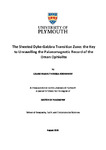The Sheeted Dyke-Gabbro Transition Zone: the Key to Unravelling the Palaeomagnetic Record of the Oman Ophiolite
| dc.contributor.supervisor | Morris, Antony | |
| dc.contributor.author | Koornneef, Louise Maria Theresia | |
| dc.contributor.other | School of Geography, Earth, and Environmental Sciences | en_US |
| dc.date.accessioned | 2020-09-24T14:40:53Z | |
| dc.date.issued | 2020 | |
| dc.date.issued | 2020 | |
| dc.identifier | 10541202 | en_US |
| dc.identifier.uri | http://hdl.handle.net/10026.1/16421 | |
| dc.description.abstract |
The Oman ophiolite is a natural laboratory for the study of processes operating above a nascent subduction zone. It formed in the Late Cretaceous by supra-subduction zone spreading and shortly afterwards was emplaced onto the Arabian continental margin. Twelve massifs in the ophiolite expose complete sections of the Neotethyan oceanic lithosphere, including upper mantle peridotites, lower crustal gabbros, and upper crustal sheeted dykes and lava flows. Previous palaeomagnetic studies have suggested that the southern massifs of the ophiolite were affected by a large-scale remagnetization event during emplacement, which completely replaced original remanences acquired during crustal accretion. In contrast, primary magnetizations are preserved throughout its northern massifs. This study therefore aims to: (i) apply palaeomagnetic, magnetic fabric and rock magnetic techniques to analyse systematically crustal sections through the southern massifs of the Oman ophiolite to investigate the extent and nature of this remagnetization event; and (ii) to use any primary magnetizations that survived this event to document intraoceanic rotation of the ophiolite prior to emplacement. Results demonstrate that remagnetization occurred from the base of the ophiolite upwards, and involved the acquisition of a chemical remanence that decreases in intensity up-section, related to upwards expulsion of orogenic fluids during obduction onto the Arabian continent. Magnetic fabrics in layered gabbros and dykes are aligned with macroscopic magmatic structures (layering and dyke margins), indicating that the distribution of new magnetic phases during remagnetization was controlled by existing silicate fabrics. Remagnetization appears to have been pervasive throughout the southern massifs, except at one locality (Wadi Abyad) where primary magnetizations are inferred to be preserved in the sheeted dyke complex at the top of the exposed section. Similar primary remanences were isolated at a control locality in the Salahi massif, outside of the region of remagnetization. Net tectonic rotation analysis at these non-remagnetised sites shows an initial NNE-SSW strike for the supra-subduction zone ridge during spreading, comparable with recently published models for the regional evolution of the ophiolite. | en_US |
| dc.language.iso | en | |
| dc.publisher | University of Plymouth | |
| dc.rights | CC0 1.0 Universal | * |
| dc.rights.uri | http://creativecommons.org/publicdomain/zero/1.0/ | * |
| dc.subject | Palaeomagnetism | en_US |
| dc.subject | Remagnetization | en_US |
| dc.subject | Ophiolite | en_US |
| dc.subject.classification | PhD | en_US |
| dc.title | The Sheeted Dyke-Gabbro Transition Zone: the Key to Unravelling the Palaeomagnetic Record of the Oman Ophiolite | en_US |
| dc.type | Thesis | |
| plymouth.version | publishable | en_US |
| dc.identifier.doi | http://dx.doi.org/10.24382/752 | |
| dc.rights.embargodate | 2021-03-24T14:40:53Z | |
| dc.rights.embargoperiod | 6 months | en_US |
| dc.type.qualification | Doctorate | en_US |
| rioxxterms.version | NA | |
| plymouth.orcid.id | 0000-0002-8016-1167 | en_US |
Files in this item
This item appears in the following Collection(s)
-
01 Research Theses Main Collection
Research Theses Main



